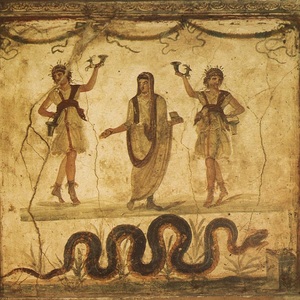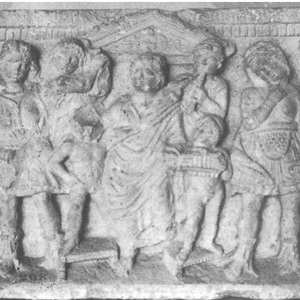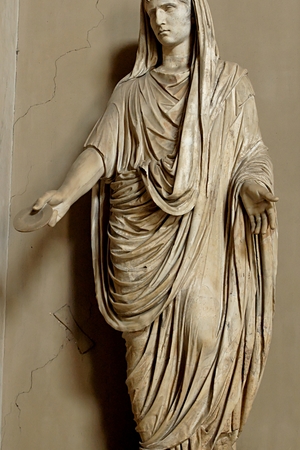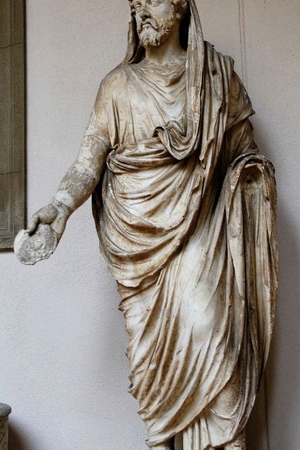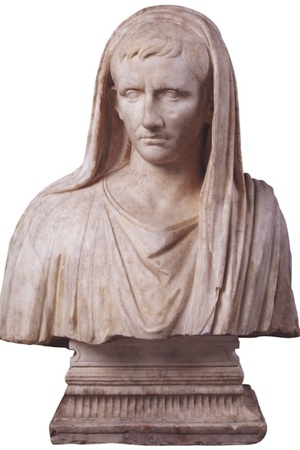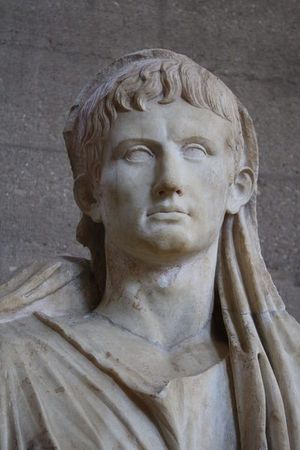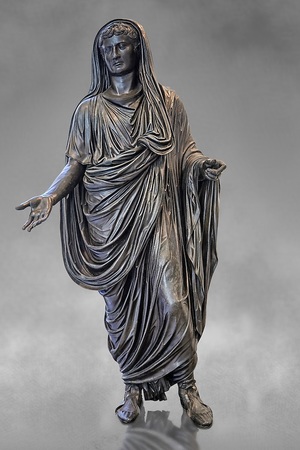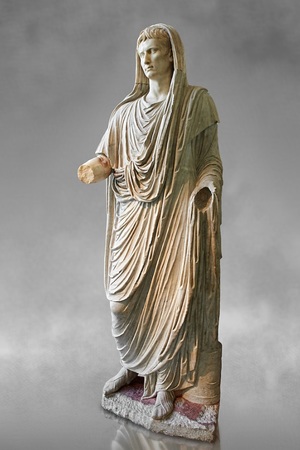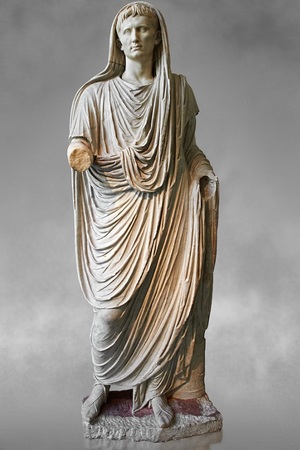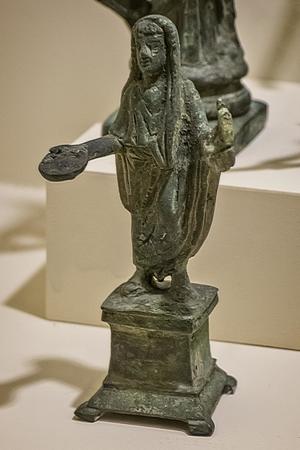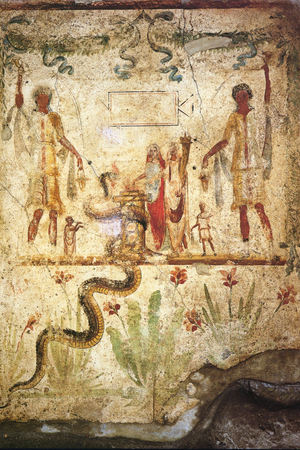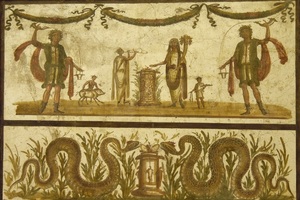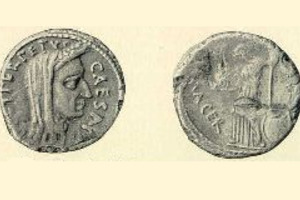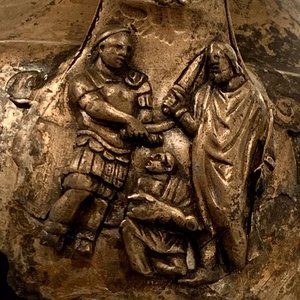Pontifex
A pontifex (Latin: pontifex, literally "bridge-builder," from pontis – bridge (genitive case) and facio – to make) was a member of the highest college of priests in Ancient Rome, responsible for overseeing religious affairs in the state. Sometimes translated into English as pontifex.
The insignia of the pontifices included ritual items: a special dish for offerings, a sacrificial vessel, a knife, and a uniquely draped toga covering the head. The college was not associated with the cult of any specific deity but was responsible for religious processes within the state as a whole. The pontifices oversaw the sanctity of religious rituals and norms of behavior (for both priests and ordinary citizens). Their duties also included maintaining the calendar and adjudicating religious matters. In the realm of family law, the college was responsible for preserving the sacred family and ancestral rites of Rome. Additionally, they participated in the archaic marriage ceremony (confarreatio), supervised adoptions, and announced wills.
Originally, one of the main duties of the pontifices was the maintenance of the sacred bridge (pons sublicius) over the Tiber River. The creation of the college of pontifices is usually attributed to Numa Pompilius, who became the first pontifex maximus. Initially, the college consisted of 5 members (including the pontifex maximus). Under Lucius Sulla, their number was increased to 15, and under Gaius Julius Caesar, to 16. During the imperial period, the number of pontifices was not regulated, and the emperor held the title of pontifex maximus, with the power to change their number at his discretion. The organizational structure of the college also included the rex sacrorum (king of sacred rites), flamines (three senior flamines maiores and twelve junior flamines minores), and the Vestal Virgins.
The influence of the pontifices in the field of jurisprudence and religious law was particularly significant in the early Republic, before plebeians were granted equal rights with patricians. After plebeians were admitted to the pontificate in 300 BCE, the influence of the college began to gradually decline. The first great pontifex from the plebeians was Tiberius Coruncanius in 254 BCE.
Another event that undermined the authority of the pontificate occurred in 131 BCE when the consul Licinius Crassus departed with his army to Asia Minor, despite not having the right to leave Italy as pontifex maximus. Following this incident, the law prohibiting the pontifex maximus from leaving the Italian peninsula was not violated until the 1st century BCE when Gaius Julius Caesar, holding the office of pontifex maximus, went to war in Gaul. As the foundations of Republican values further eroded, so did the authority of the pontificate. Augustus restored the significance of the college by making the title of pontifex maximus exclusively imperial. To handle administrative duties, the position of promagister was established in 155 CE, appointed for one year.
Interestingly, the pontificate outlasted the paganism of Ancient Rome. In 382 CE, Gratian renounced the title of pontifex maximus to break with the ancient religion. Later, the title of pontifex maximus was transferred to the Roman pontiff — the Pope.
Supreme Pontiff
The Pontifex Maximus (Latin: Pontifex Maximus, literally "Greatest Bridge-Builder") was the chief priest, head of the college of pontifices. Originally the highest priestly office in Ancient Rome, it was a lifetime position. From 753–712 BCE, it was held by the kings.
The Pontifex Maximus led the college of pontifices and supervised the so-called rex sacrorum (king of sacred rites), flamines, and Vestal Virgins. If any priest or pontifex violated their duties, the Pontifex Maximus imposed a fine (multa). Although the people had the right to criticize the pontifex's decisions, in known cases, they generally supported him. The Pontifex Maximus also kept annual official records of omens (annales maximi). One of the distinguishing symbols of the Pontifex Maximus was a special iron sacrificial knife (secespita). For the election of the Pontifex Maximus, 17 of the 35 tribes were chosen by lot to vote individually in the comitia tributa. This procedure was abolished by Sulla but reinstated by Labienus in 63 BCE. After Augustus, the position was held by the emperors.
Interestingly, the pontificate survived paganism in Ancient Rome. In 382 CE, Gratian renounced the title of Pontifex Maximus to break with the ancient religion. Later, the title of Pontifex Maximus was transferred to the Roman pontiff — the Pope.
Reconstruction
To reconstruct Pontifex, you must first have a wool tunic with red stripes and a white toga with a red border around the perimeter. There are no strict restrictions on the choice of shoes, pontiffs could wear sandals and calzees. The reenactor also needs to make copies of priestly insignia.
Related topics
Literature
Pontifex / / Small encyclopedia of Brockhaus and Efron : in 4 volumes-St. Petersburg, 1907-1909.
Pontifex / / "Dictionary of Greek and Roman Antiquities" by William Smith, London, 1870, pp. 939-942.
Smorchkov A.M. Collegium of Pontiffs / / Priestly colleges in Early Rome, Moscow, 2001;
Kavanagh B.J. Pontifices, Bridge-Making and Ribezzo Revisited // Glotta. 2000. Vol. 76. № 1–2
Bleicken J. Oberpontifex und Pontifikalkollegium: Eine Studie zur Römischen Sakralverfassung // Hermes. 1957. Bd 85. № 3
Wissowa G. Religion und Kultus der Römer. Münch., 1912
Roman Religion in Archaic and Republican Rome.pdf
Religion and power in the Roman Republic Magistrates priests Morel temples. pdf

 Gallery
Gallery






